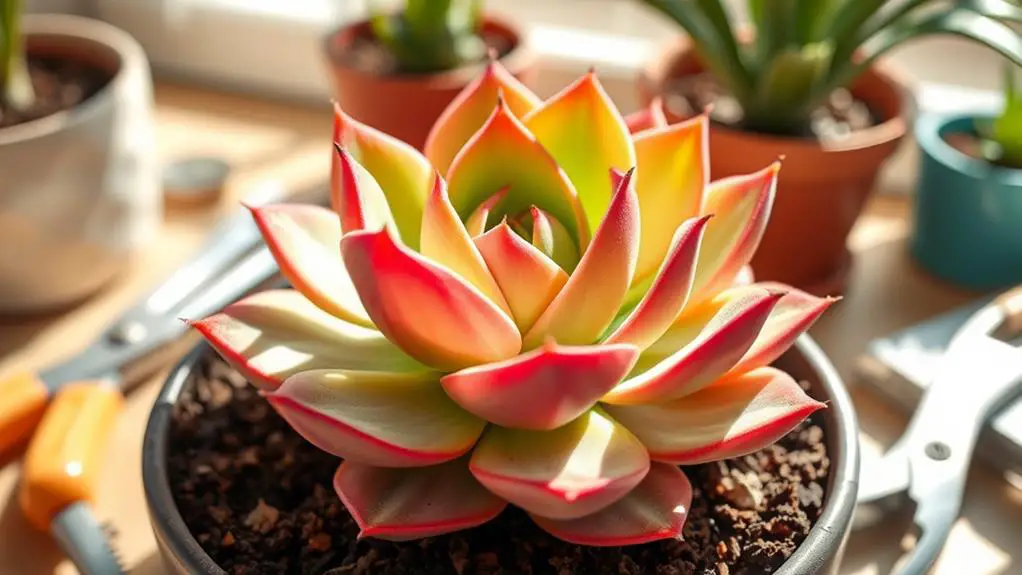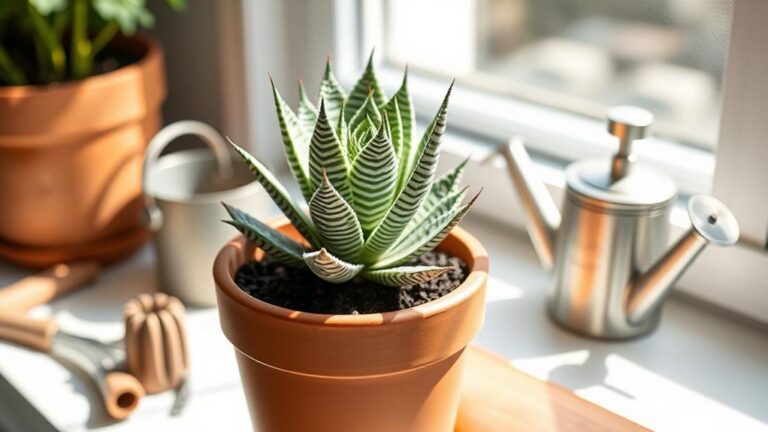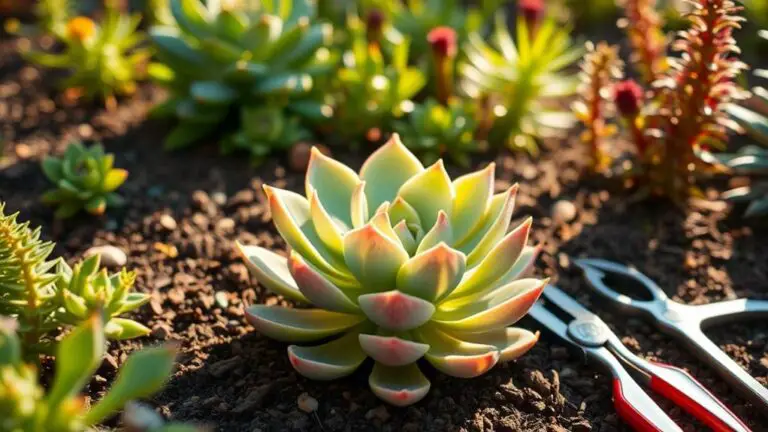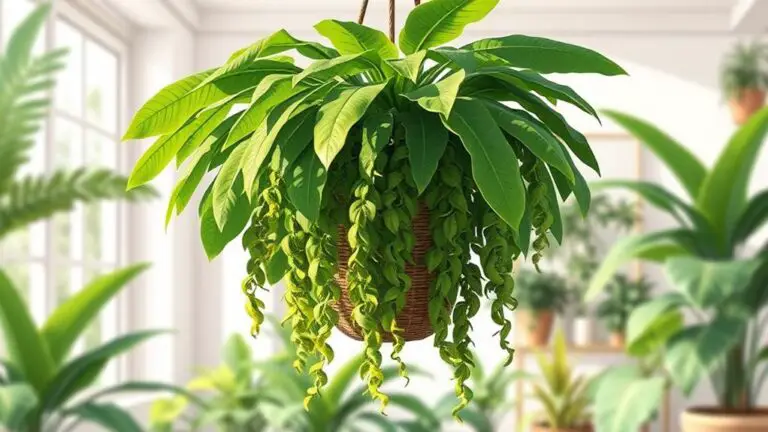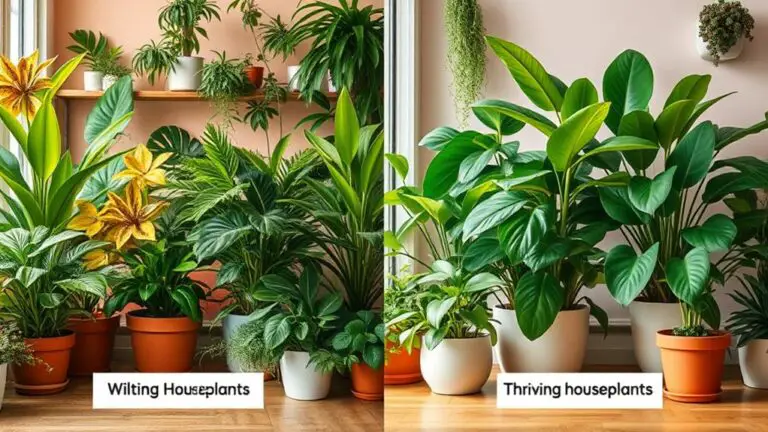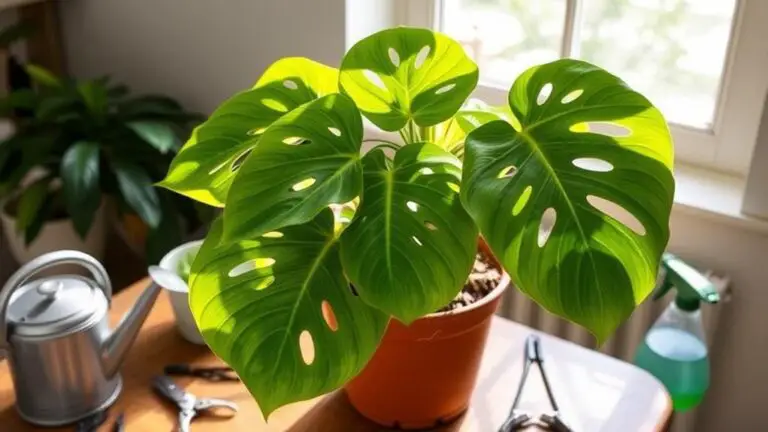7 Steps to Perfectly Care for Your Echeveria Agavoides ‘Lipstick’
Caring for your Echeveria Agavoides 'Lipstick' involves a series of steps that guarantee it thrives in your home or garden. You'll need to take into account factors like sunlight, watering frequency, soil composition, and pest control to maintain its vibrant appearance. Begin by providing at least six hours of direct sunlight each day, but that's just the start. You'll also want to master the art of infrequent watering and learn about appropriate fertilization practices. Curious about how to handle pests or propagate this stunning succulent? Keep going to uncover all seven steps and become a pro at Echeveria care.
Plant Overview

When considering a resilient and visually striking addition to your garden or indoor plant collection, search no more than the Echeveria Agavoides 'Lipstick'. This succulent features a stunning rosette shape and vibrant red-tipped leaves that resemble lipstick, making it a standout in any setting.
Growing up to 6 inches in height and spreading approximately 12 inches in width, it adds both beauty and charm to your space.
Native to Mexico, the Echeveria Agavoides 'Lipstick' is known for its endurance and symbolism of lasting love and resilience. It's an excellent choice if you want a plant that's both easy to care for and visually appealing.
One of the great things about this succulent is that it's non-toxic, making it safe for both pets and humans, which is always a plus.
To guarantee your plant has healthy leaves, it's essential to provide proper care. It thrives in USDA Hardiness Zones 9 to 11.
Make sure your pot has drainage holes to prevent water from sitting at the bottom, which can cause root rot.
Ideal Growing Conditions
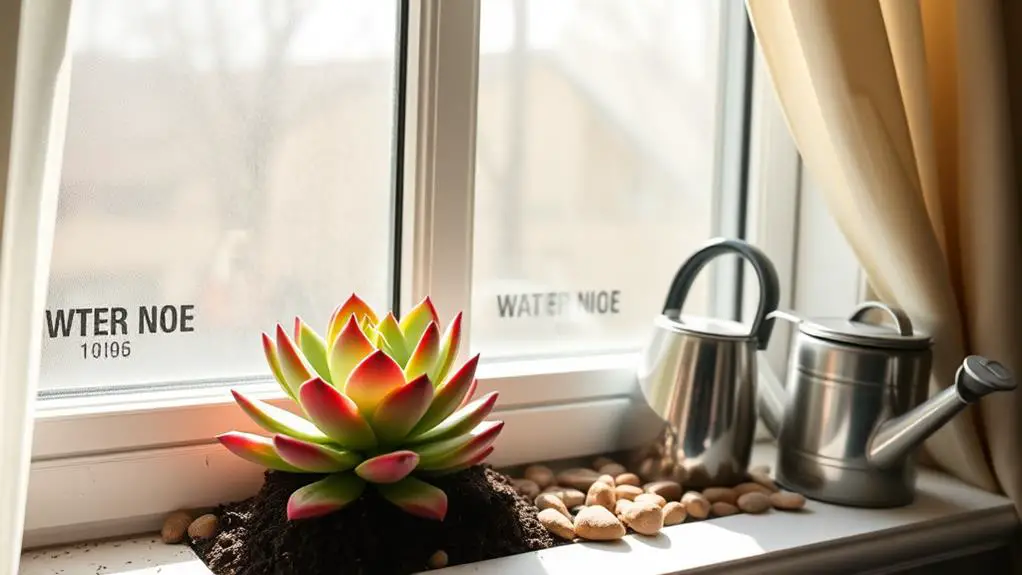
To guarantee your Echeveria Agavoides 'Lipstick' thrives, focus on providing the right growing conditions. This stunning succulent needs at least six hours of bright, direct sunlight daily. Without enough light, its vibrant red leaf edges won't develop fully.
If you live in USDA Hardiness Zones 9-11, you're in luck—this plant loves warm climates and will flourish outdoors. For indoor growers, placing your Echeveria near a sunny window will do the trick.
It's also important to take into account the temperature. Keep the environment between 65°F to 80°F (18°C to 27°C) for best growth. Avoid exposing your succulent to frost or extreme humidity, as these conditions can damage the plant.
Soil is another essential factor. Echeveria Agavoides 'Lipstick' prefers well-draining soil to prevent root rot. A mix of cactus soil with perlite or sand works well.
Regularly monitor the soil moisture and let it dry completely between waterings. This helps avoid overwatering, which can lead to root rot.
Watering Guidelines
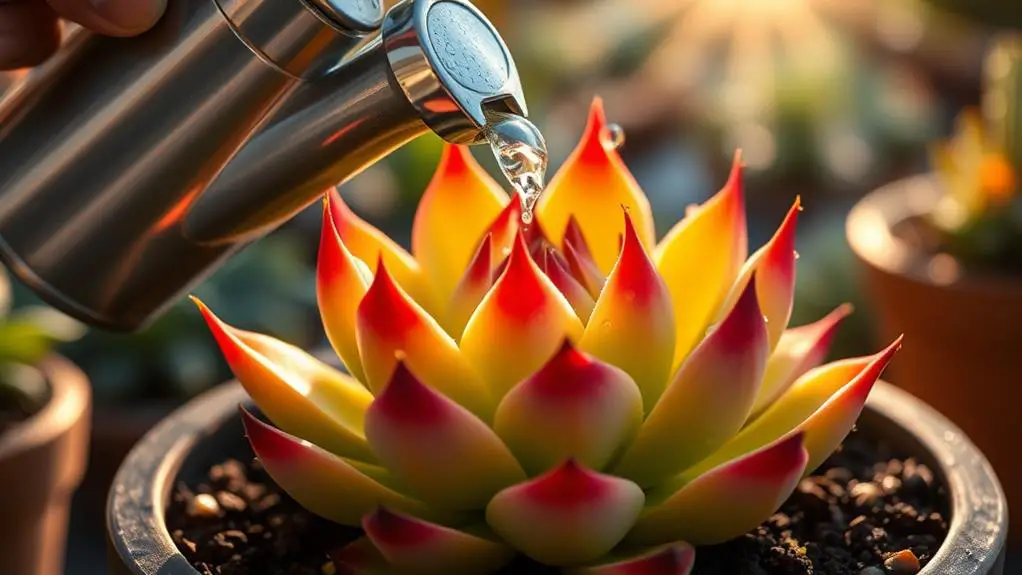
Caring for your Echeveria Agavoides 'Lipstick' involves more than just providing the right light and temperature. Proper watering is essential to keeping your plant healthy.
You'll need to water infrequently, allowing the soil to dry completely between waterings. This prevents root rot, which can be fatal for your succulent.
During the growing season, which spans spring and summer, deep watering every 1-2 weeks is ideal. Make sure the water drains completely out of the pot to avoid excess soil moisture.
In winter, reduce watering considerably. Only water when the top 2-3 inches of soil feel dry to the touch. This helps the plant adapt to its dormant period.
Be attentive to signs of underwatering, like leaf curling and wrinkling. Overwatering shows up as yellowing leaves and mushy stems, so finding the right balance is key.
Always use room temperature water and soak the soil thoroughly. Avoid wetting the leaves to minimize the risk of fungal infections.
Fertilization Practices
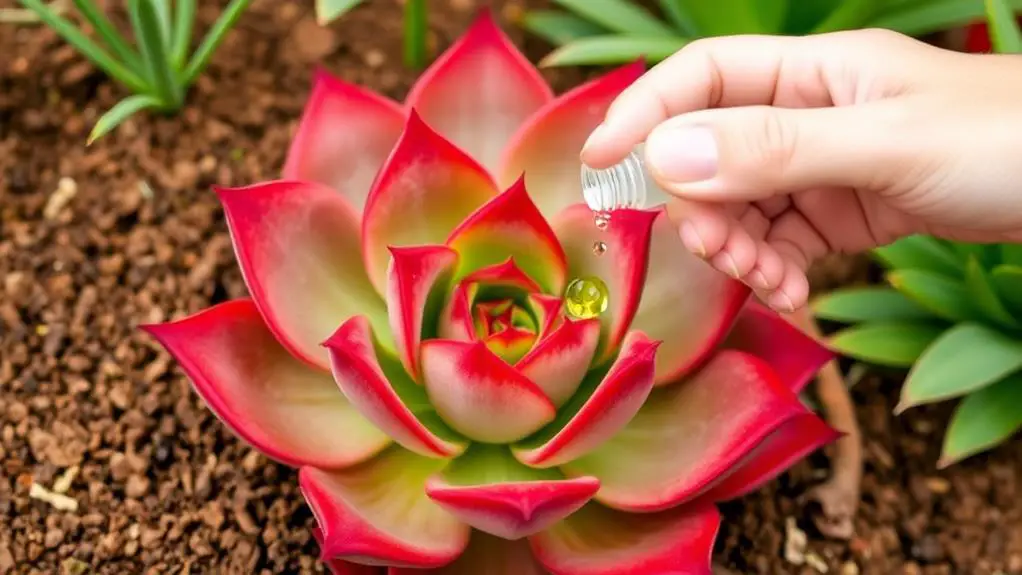
Fertilizing your Echeveria Agavoides 'Lipstick' is a straightforward task, but it's crucial to get it right to guarantee your succulent thrives. During the growing season, which spans spring and summer, you should lightly feed your plant every 4-6 weeks. Use a diluted balanced fertilizer for this purpose.
Remember, succulents like Echeveria Agavoides are sensitive to concentrated nutrients. So, make sure you dilute the fertilizer to half strength to avoid any harm.
When considering fertilization, organic matter like compost or worm castings can be beneficial. However, be cautious not to overdo it. Over-fertilization can lead to nutrient buildup, which may cause yellowing leaves and other health issues for your plant.
Always monitor your Echeveria for signs of stress, such as yellowing leaves, so you can adjust your feeding practices if needed.
It's also important to avoid fertilizing in the fall and winter. During these months, your Echeveria enters a dormant phase, and extra nutrients aren't necessary. In fact, fertilizing during this time can be harmful.
Pest and Disease Management

Keeping your Echeveria Agavoides 'Lipstick' healthy involves vigilant pest and disease management. Start by regularly inspecting your plant for common pests like mealybugs, aphids, and spider mites. These tiny invaders can harm your succulent if not dealt with promptly. At the first sign of infestation, treat the affected areas with insecticidal soap or neem oil. Follow up as needed to guarantee the pests are completely gone.
Fungal infections, often caused by overwatering, can also pose a threat to your Echeveria. Symptoms like yellowing leaves or wilting are warning signs. To prevent these issues, make certain your plant has excellent drainage. Healthy plants are less likely to be affected by diseases and pests, so ideal care is essential.
If you notice discolored leaves or wilting, act quickly to find the cause. It could be a pest problem or a sign of disease.
| Common Pests | Symptoms | Solutions |
|---|---|---|
| Mealybugs | White, cottony spots | Insecticidal soap, neem oil |
| Aphids | Sticky residue | Neem oil, remove manually |
| Spider Mites | Webbing, yellowing | Insecticidal soap |
Propagation Techniques

To guarantee your Echeveria Agavoides 'Lipstick' thrives, effective propagation techniques are key. You can propagate this succulent through leaf cuttings or offsets, with the best results in spring or summer.
For leaf cuttings, start by selecting a healthy leaf. Gently twist it off the main plant, ensuring it comes off cleanly. Let the leaf callous for 3-5 days before placing it on a well-draining medium. This step is essential, as it allows the wound to heal, reducing the chance of rot.
Once calloused, place the leaf on soil and wait for it to root. Be patient; roots will form over a few weeks.
If you prefer using offsets, gently remove them from the base of the main plant. Like leaf cuttings, allow the offsets to callous before planting. Place them in a well-draining succulent mix to promote healthy growth.
Remember to let the soil dry out between waterings to prevent rot. Gradually acclimate new plants to brighter light conditions. Start them in indirect light and slowly move them to brighter spots. This helps avoid stress, ensuring your new plants grow strong and healthy.
Seasonal Care Adjustments
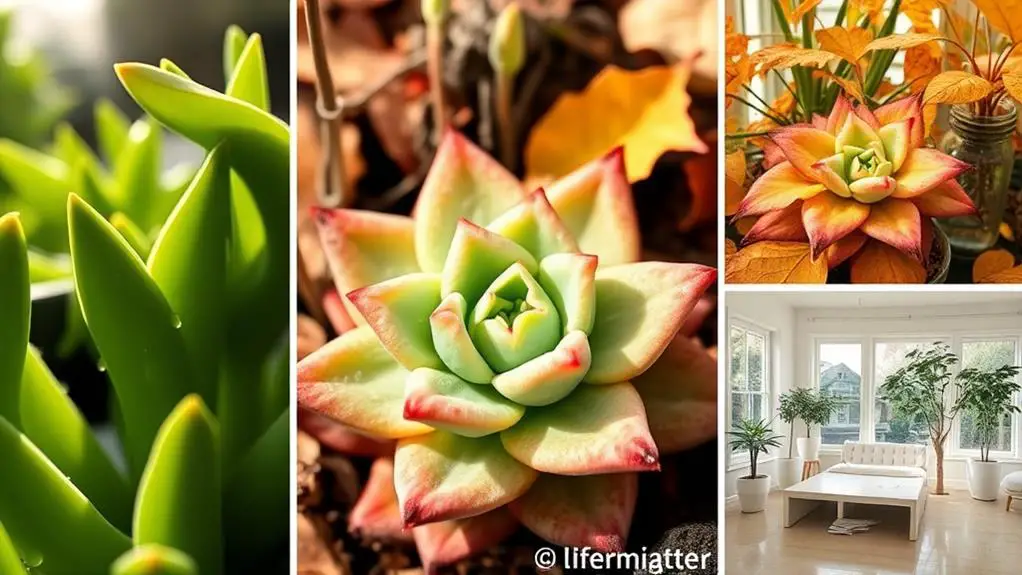
When caring for Echeveria Agavoides 'Lipstick', you need to adjust your routine with the changing seasons.
In the summer, make certain your plant gets plenty of bright sunlight and water it every 1-2 weeks as it grows.
During the winter, cut back on watering to once every 2-4 weeks and move your plant closer to a window to guarantee it still gets enough light.
Winter Watering Reduction
During the winter months, it's crucial to greatly reduce the watering frequency for your Echeveria Agavoides 'Lipstick'. This succulent enters a dormant phase and needs less moisture to prevent root rot.
Allow the top 1-2 inches of soil to dry out completely before watering again. Typically, this means you should water every 2-4 weeks.
When you do water, use room temperature water to avoid shocking the plant's roots. Make sure any excess water drains out of the pot's drainage holes to prevent soggy soil. Too much moisture can harm your succulent.
Despite the reduced watering, keep your Echeveria in a well-lit area. Adequate direct light will help maintain its health during the winter.
If you notice wrinkled or curled leaves, it's a sign that your plant may need more water. But remember, new plants might require a slightly different care routine until they're well-established.
Summer Sun Exposure
Summer sun can be both a blessing and a challenge for your Echeveria Agavoides 'Lipstick'. This succulent needs at least 6 hours of bright, direct sunlight daily to show off its stunning red leaf edges and stay healthy. For outdoor gardens, place it where it gets southern or western exposure. Indoors, make certain it's near a sunny window.
However, be on the lookout for signs of sunburn, like leaf bleaching or browning. Too much intense sunlight, especially during peak hours, can harm your plant. If you notice these signs, move the plant to a slightly shadier spot or use a sheer curtain to filter the light.
In summer, your watering routine will need some adjusting. Let the top 2-3 inches of your soil mix dry out completely between waterings. This helps avoid overwatering, which can damage the root system.
If you're moving your Echeveria Agavoides 'Lipstick' from indoors to outdoors, do it gradually. Sudden changes in light can shock the plant and damage its leaves. Start by placing it in a shaded area and slowly increase its exposure to bright, direct sunlight over a week or two.
This careful approach guarantees your succulent thrives all summer long.
Frequently Asked Questions
How to Care for Echeveria Agavoides Lipstick?
Make certain your Echeveria Agavoides 'Lipstick' gets 6 hours of direct sunlight. Water infrequently, letting soil dry out. Use cactus mix soil. Fertilize every 4-6 weeks in spring and summer. Inspect for pests and repot every 2-3 years.
How Often Should You Water an Echeveria Agavoides?
You should water your Echeveria Agavoides every 1-2 weeks in spring and summer, ensuring the soil dries out completely between waterings. In winter, reduce watering to once every 3-4 weeks due to dormancy.
How Often Should I Water Lipstick in Echeveria?
You should water your Lipstick Echeveria every 1-2 weeks during spring and summer, letting the soil dry completely between waterings. In winter, reduce watering to once every 3-4 weeks as the plant goes dormant.
How to Take Care of an Echeveria Plant?
You should place your Echeveria in bright sunlight, water only when the soil is dry, use well-draining soil, and fertilize sparingly during the growing season. Regularly check for pests and treat them promptly.
Conclusion
Caring for your Echeveria Agavoides 'Lipstick' might seem tricky at first, but with these seven steps, you'll soon feel like a pro. Make sure it gets plenty of sunlight, don't overwater, use the right soil, and fertilize carefully. Keep an eye out for pests and propagate during the right seasons. Remember, patience and attention are key. You've got this! Your plant will thrive, and you'll enjoy watching it grow beautifully. Happy gardening!

